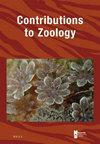Morphological variation during post-embryonic development in the centipede Lithobius melanops: traditional and geometric morphometrics approaches
IF 2.2
2区 生物学
Q1 ZOOLOGY
引用次数: 0
Abstract
Two modes of post-embryonic development, hemianamorphosis and epimorphosis, show a distinct pattern among extant centipede (Chilopoda) orders. Although studies on post-embryonic development in Lithobiomorpha date back to the 19th and the 20th century, many ambiguities referring to nomenclature of their post-embryonic stages still exist. In this paper coherent terminology of the post-embryonic stages in Lithobius melanops, which could be applied to other lithobiomorphs, is proposed. Additionally, morphological variability of selected morphological traits was analyzed using traditional and geometric morphometric approaches. We recognized five anamorphic (anamorph 0 to 4) and five epimorphic stages (agenitalis, immaturus, praematurus, pseudomaturus and maturus). Measurement and count of certain morphometric characters, detailed description of genital appendages, shape and size variation of the forcipular apparatus, the cephalic capsule and the terminal legs are given. Moreover, for the purpose of geometric morphometric analyses we separated specimens of epimorphic stages into three groups (agenitalis-, praematurus- and maturus-like) based on the level of differentiation of genital appendages. Sexual size dimorphism of the forcipular apparatus was observed only in the praematurus group. Also, significant inter-group forcipular size and shape differences are found between some tested groups. Furthermore, significant differences in size and shape were recorded for the cephalic capsule between all groups. Finally, significant size differences in ultimate legs are present between all epimorphic groups, while shape differences were detected only between agenitalis and maturus groups. Our results contribute to overcoming terminological disparities and provide guidelines for distinguishing stages via discrete and continuous changes during post-embryonic development of the anamorphic centipede.黑蜈蚣胚胎后发育过程中的形态学变化:传统和几何形态计量学方法
在现存的蜈蚣目中,胚胎后发育的半形态和差形态两种模式表现出不同的模式。尽管对石藻胚胎后发育的研究可以追溯到19世纪和20世纪,但关于其胚胎后阶段的命名仍然存在许多歧义。本文提出了黑石斑虫胚胎后阶段的连贯术语,可用于其他石斑虫形态。此外,使用传统和几何形态计量方法分析了所选形态性状的形态变异性。我们识别了五个变形阶段(变形0到4)和五个浅形态阶段(无尾目、无尾目,前尾目、拟成熟目和成熟目)。对某些形态计量特征的测量和计数,生殖器附件的详细描述,对口器、头囊和末端腿的形状和大小变化进行了描述。此外,为了进行几何形态计量学分析,我们根据生殖器附属物的分化水平,将浅形态阶段的标本分为三组(似无颌龙、似颌龙和似成熟龙)。前掌器的性别大小二型性仅在掌龙组中观察到。此外,在一些受试组之间,发现了显著的组间枕骨大小和形状差异。此外,各组头包膜的大小和形状存在显著差异。最后,所有浅形态组的最终腿部存在显著的大小差异,而只有发育不全组和成熟组的形状存在差异。我们的研究结果有助于克服术语上的差异,并为通过变形蜈蚣胚胎后发育过程中的离散和连续变化来区分阶段提供指导。
本文章由计算机程序翻译,如有差异,请以英文原文为准。
求助全文
约1分钟内获得全文
求助全文
来源期刊

Contributions to Zoology
生物-动物学
CiteScore
4.00
自引率
4.50%
发文量
16
审稿时长
>12 weeks
期刊介绍:
Contributions to Zoology solicits high-quality papers in all systematics-related branches of comparative zoology (including paleozoology). Preference will be given to manuscripts dealing with conceptual issues and to integrative papers (e.g., ecology and biodiversity, morphology and phylogeny and character state evolution, phylogeny and historical biogeography, systematics and bioinformatics, bioinformatics and biodiversity, habitat disturbance and biogeography, etc.). Reviews and alpha-taxonomic contributions are considered for publication, but acceptance will depend on their high quality and exceptional nature.
 求助内容:
求助内容: 应助结果提醒方式:
应助结果提醒方式:


